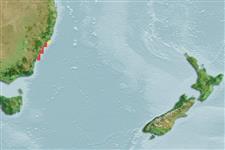Teleostei (teleosts) >
Gobiiformes (Gobies) >
Gobiidae (Gobies) > Gobiinae
Etymology: Istigobius: Greek, istios = sail + Latin, gobius = gudgeon (Ref. 45335).
Eponymy: Dr Douglass Fielding ‘Doug’ Hoese (d: 1942) is Senior Fellow, Ichthyology Collection, Australian Museum, Sydney. [...] (Ref. 128868), visit book page.
Environment: milieu / climate zone / depth range / distribution range
Ecology
Marine; demersal; depth range 5 - 7 m, usually 5 - 7 m (Ref. 27115). Subtropical; 22°C - 27°C (Ref. 27115); 30°S - 37°S
Southwest Pacific: in bays near Sydney, New South Wales, Australia. One specimen tentatively identified as this species was collected from Guadalcanal, Solomon Islands.
Size / Weight / Age
Maturity: Lm ? range ? - ? cm
Max length : 6.0 cm TL male/unsexed; (Ref. 420); 6.6 cm TL (female)
Dorsal spines (total): 7; Dorsal soft rays (total): 10 - 11; Anal spines: 1; Anal soft rays: 9 - 10; Vertebrae: 26. Body grayish white. Upper pectoral fin rays entire. Predorsal cycloid scales 8-12; ctenoid on trunk. Head greenish brown with faint yellow-orange band diagonally on preoperculum and operculum with some black areas on the former; lateral part of jaws, especially upper, black. Males usually darker than females; length of anal, pelvic and 2nd dorsal fins longer in males.
Collected from silty sand near large rocks.
Life cycle and mating behavior
Maturity | Reproduction | Spawning | Eggs | Fecundity | Larvae
Male genital papilla usually ending to side of anal. Female genital papilla truncate and ending well before the origin of anal fin.
Murdy, E.O. and D.F. Hoese, 1985. Revision of the gobiid fish genus Istigobius. Indo-Pac. Fish. (4):41 p. (Ref. 420)
IUCN Red List Status (Ref. 130435: Version 2024-1)
Threat to humans
Harmless
Human uses
Fisheries: commercial; aquarium: commercial
Tools
Special reports
Download XML
Internet sources
Estimates based on models
Preferred temperature (Ref.
123201): 20.2 - 21.8, mean 21.2 °C (based on 9 cells).
Phylogenetic diversity index (Ref.
82804): PD
50 = 0.5010 [Uniqueness, from 0.5 = low to 2.0 = high].
Bayesian length-weight: a=0.01023 (0.00477 - 0.02194), b=3.01 (2.83 - 3.19), in cm total length, based on LWR estimates for this (Sub)family-body shape (Ref.
93245).
Trophic level (Ref.
69278): 3.2 ±0.3 se; based on size and trophs of closest relatives
Resilience (Ref.
120179): High, minimum population doubling time less than 15 months (Preliminary K or Fecundity.).
Fishing Vulnerability (Ref.
59153): Low vulnerability (10 of 100).
Nutrients (Ref.
124155): Calcium = 386 [154, 1,021] mg/100g; Iron = 1.89 [0.99, 4.08] mg/100g; Protein = 18.4 [16.4, 20.1] %; Omega3 = 0.341 [0.132, 0.727] g/100g; Selenium = 12.1 [5.3, 28.4] μg/100g; VitaminA = 24.2 [6.1, 88.8] μg/100g; Zinc = 1.69 [1.06, 2.72] mg/100g (wet weight);
